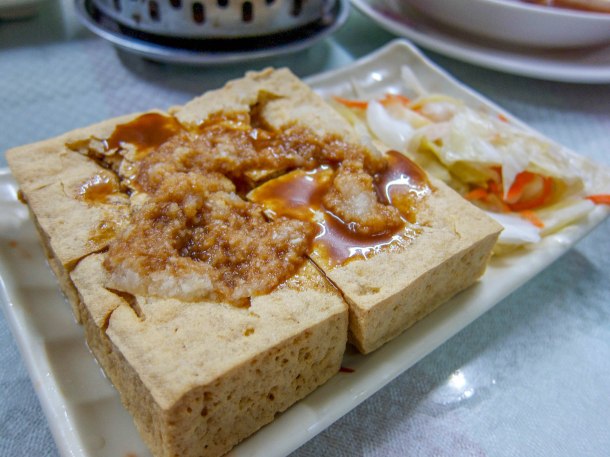Stinky Tofu
You may be familiar with stinky tofu’s strong, pungent odor that makes you wrinkle your nose in disgust. Although this dish certainly lives up to its name, taking a bite into its crunchy, deep-fried exterior that gives way to warm, firm tofu might just make you a stinky tofu convert. A popular street food in Taiwan, Hong Kong, and parts of China, stinky tofu is a fermented tofu dish that is often deep-fried, drizzled with a salty sauce, and served with a side of pickled vegetables. This dish can also be found simmered in spicy hot pot, grilled on skewers, and mixed into rice porridge. So what is the secret to its stink?
It starts with the brine used to ferment the tofu. The conventional process involves adding shelled shrimp and vegetables such as bamboo shoots and Chinese green cabbage to salt water in wide mouth jars. These jars are then exposed to air for several months to allow the brine to undergo natural microbial fermentation that results in its unique stinky smell. Bricks of tofu are then soaked in the liquid for 4-6 hours to develop its flavor [1].
The major bacteria strains that that contribute to the fermentation process include Bacillus sphaericus, Enterococcus gallinarum, Acinetobacter spp., and Corynebacterium spp. [1]. Microbes of the Bacillus genus secrete proteases that hydrolyze, or break down, the tofu proteins into their constituent amino acids (aka the building blocks of proteins) and peptides (molecules made of multiple amino acids) [2]. Two important sulfur-containing amino acids, cysteine and methionine, degrade during the fermentation process and form various sulfides that are responsible for those sulfurous, meaty, and onion odors [3].
If that is not stinky enough, the volatile flavor compound that contributes most to stinky tofu’s smell is indole, which is associated with fecal and animal odors. Less potent flavor compounds include esters, alcohols, aldehydes and ketones, which confer sweet and fruity odors. In fact, a research study analyzing volatile flavor compounds in a sample of fermented stinky tofu identified a total of 39 compounds that contribute to its smell [3]. Considering how molecules become even more volatile when heated (diffusion speeds up with higher temperatures), helps to further explain why you get a burst of stinky odor when stinky tofu is deep-fried [4].
Stinky tofu definitely lives up to its name, but don’t let the smell deter you from trying the dish. After all, if you end up loving it you will never have trouble finding a stinky tofu stand if you just follow your nose!
References cited
- Chang, H., Wang, S., Chen, J., & Hsu, L. “Mutagenic Analysis of Fermenting Strains and Fermented Brine for Stinky Tofu.” Journal of Food and Drug Analysis. 9.1 (2001): 45-49. Web.
- Stinky tofu. Microbe Wiki.
- Liu, Y., Miao, Z., Guan, W., Sun, B. “Analysis of Organic Volatile Flavor Compounds in Fermented Stinky Tofu Using SPME with Different Fiber Coatings.” 17 (2012): 3708-3722. Web.
- Hui, Y.H. (2007). Handbook of Food Science, Technology, and Engineering (Vol. 4). Hoboken, NJ: Wiley & Sons, Inc.
 About the author: Catherine Hu received her B.S. in Psychobiology at UCLA. When she is not writing about food science, she enjoys exploring the city and can often be found enduring long wait times to try new mouthwatering dishes.
About the author: Catherine Hu received her B.S. in Psychobiology at UCLA. When she is not writing about food science, she enjoys exploring the city and can often be found enduring long wait times to try new mouthwatering dishes.


